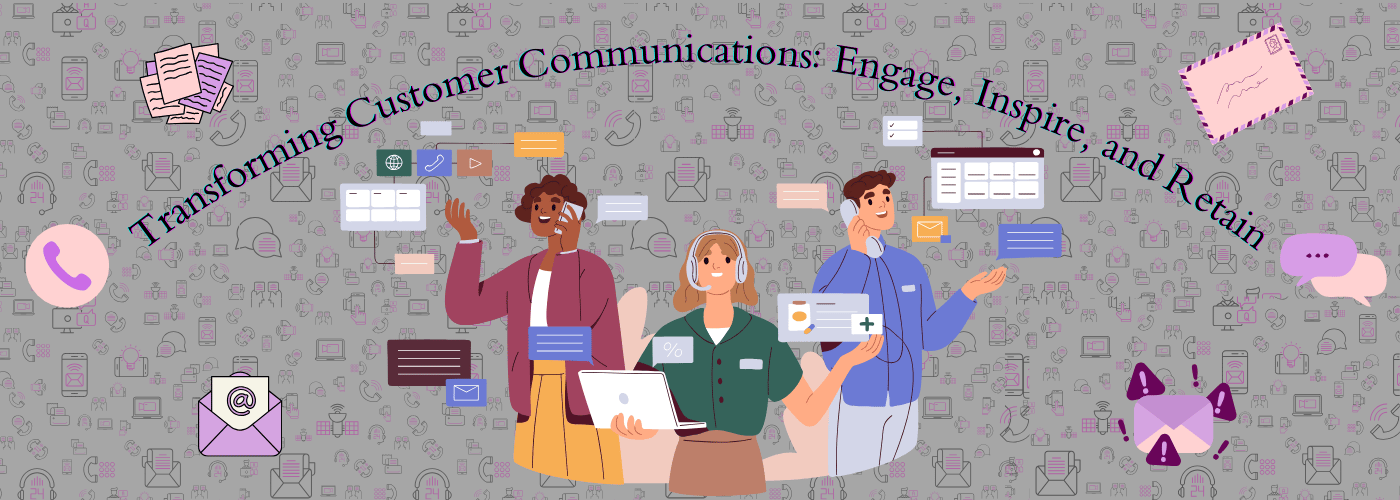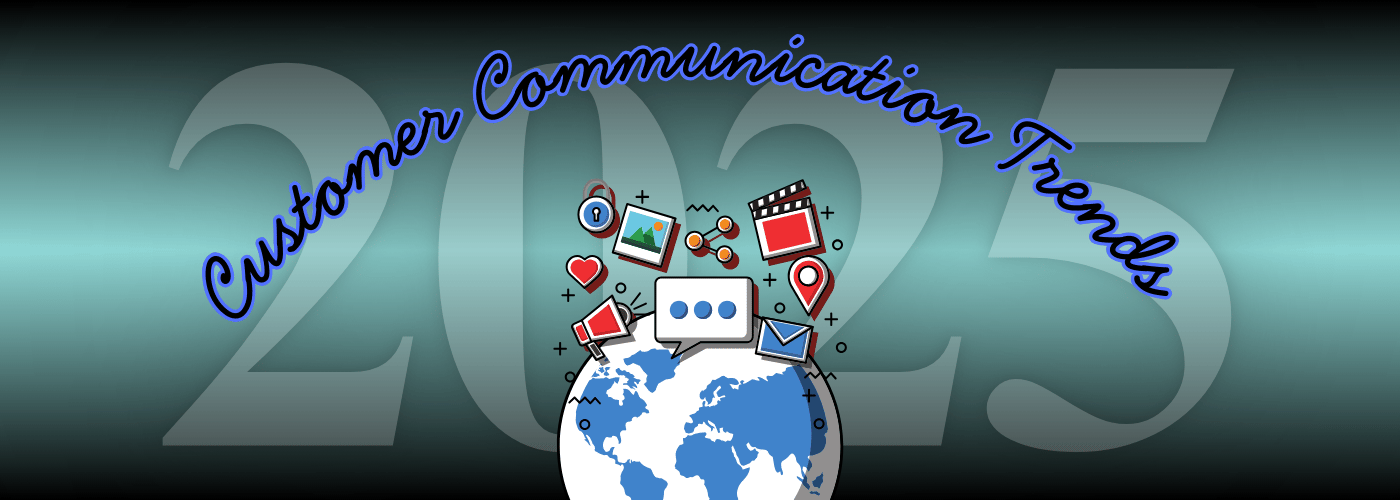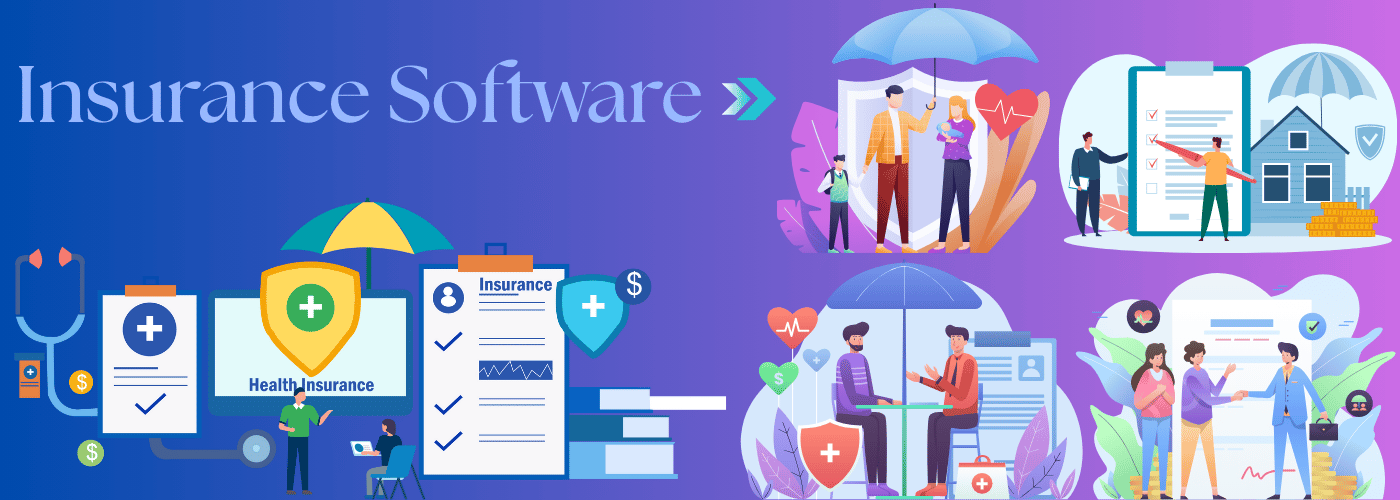
The Vital Importance of Communication
Imagine a customer reaching out to your organization, eager to receive important documents, only to be met with confusion and delays. The day and age mean that there are numerous large organizations with a huge client base. Considering the sheer volume of clients, there will inevitably be those who have been on hold for a long time, haven’t received a response to their complaint, or have not gotten the requested documents. Such scenarios are now commonplace; however, they also tarnish your brand’s reputation.
Now one might think, can one man’s dissatisfaction truly impact an entire organization? According to PwC, 59% of customers will abandon a brand after a single poor experience. On the other hand, Salesforce research shows that 88% of clients feel that good customer experience encourages them to make future purchases and 75% claimed to recommend an organization based on it.
If this doesn’t convince you how important proper customer communication and experiences are, look at PwC’s research. Maybe seeing the staggering gap in a range of industries and what customers expect from organizations and the client experiences organizations offer.
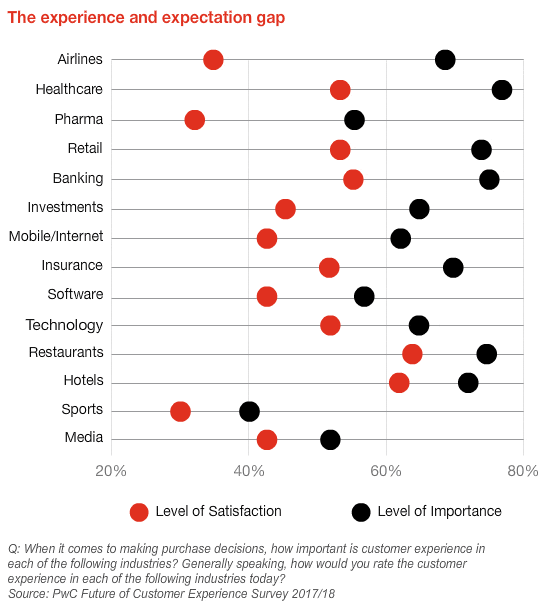
With so many people willing to pay even more for a better experience, customer communication management (CCM) is the ideal solution. CCM is a strategic approach to creating, delivering, storing, and retrieving customer communications across the entire customer lifecycle. “Your brand is not what you sell; it’s the experience you deliver.” – Tony Hsieh, Former CEO, Zappos
The History of Customer Communication Management
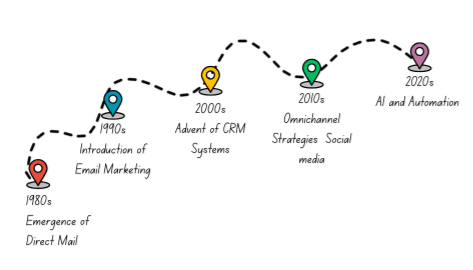
Customer Communication Management has been around since the late 20th century. In the 1980s, there were facilities with bulky mainframes and centralized printing. They sent out standardized letters, invoices, and statements. A decade later, in the 1990s and 2000s, we experienced the dawn of the digital era. PCs and emails were proving to be faster and more efficient communication methods rather than documenting everything on paper. At the same time, CRM systems had just emerged. CRMs, being siloed systems, provided a centralized view of customer data that allowed for personalization and targeting.
The 2010s experienced a boom in technology. Everything was changing and we had just stepped into the multi-channel era. Omnichannel communication and data personalization were strategies that emerged as a result of this boom. They fueled consistent and omnichannel brand experiences.
The early 2020s have witnessed the rise of artificial intelligence (AI) and machine learning (ML). Although AI and ML are quite prevalent in customer communication management, they offer AI-generated content, predictive and accurate customer engagement, and detailed client insights.
What Exactly is Customer Communication Management?
Customer Communication Management (CCM), as we now know and use it, emerged in the early 2000s during the technology boom. CCM is a strategic approach businesses use by centralizing consumer data to design, deliver, and manage customer communications. Traditional communication relied on printed letters or emails; now, the landscape has become customer-centric. Modern CCM entails a range of digital channels, including emails, SMS, phone calls, social media, chatbots, and more. The personalization, consistency, and convenience that CCM offers make it an extension to existing systems.
Adopting Customer Communication Management has obvious benefits: competitive advantage in market share, client retention, and operational efficiency.
The Key Components in Customer Communication Management
Content Creation and Management: With centralized systems, the platform can develop, store, and maintain communication templates and content elements to ensure brand consistency, compliance, and accuracy.
Delivery Channel Orchestration: The system ensures customers receive communications on their preferred channels, including print, email, SMS, mobile applications, AI chatbots, and even voice assistants.
Personalization Engines: CCM analyzes all the collected data, including but not limited to demographics, preferences, interaction history, and life events, to offer personalized communications.
Analytics: In addition to personalization, the system tracks engagement to check the effectiveness of communication in order to revise and refine communication strategies accordingly.
Workflow Automation: The platform streamlines approval processes, triggers timely communication, and supports cross-departmental collaboration.
Governance and Compliance: The system ensures strict regulatory compliance across multiple jurisdictions, reducing noncompliance issues. Such systems are quipped with centralized content libraries, regulatory update monitoring, and more.
Implementing Customer Communication Management in Your Organization

Organizations looking to adopt a customer communication management platform need to assess the current state of their organization to understand how ready they are to make the switch. This decision involved a collaborative, cross-functional, and departmental approach and is not something that just one person can handle.
Typically speaking, the stakeholders involved in this are,
- Marketing professionals and the customer service team
- Operations and IT departments
- Compliance and legal team
- Line of business leaders
Any organization should facilitate a discussion with key stakeholders to identify and prioritize their unique needs, truly comprehend the various complexities of the operations, and ensure a balanced perspective. This would help in choosing the right software solution for the organization.
Once the specific needs are identified and a solution is chosen, the organization must prepare for the implementation process. The current state of the organization needs to be evaluated across several key areas.
Is our communication inventory ready?
Organizations must catalog all communication types, volumes, channels, and owners. This can give business users a holistic picture of what they have and what they need to prepare.
What about our system landscape?
You’ll need to assess the current document generation, delivery channels, and integration points. Through this, you can gauge the gaps and challenges users face and address them.
How are we managing our content?
Evaluate your template management practices. Are you coming across redundancies? How is version control handled? Knowing this will ensure that the content is up-to-date and consistent.
Are compliance processes in check?
Reevaluate your approval workflows, audit capabilities, and regulatory controls. Compliance requirements need to be met with regulatory control.
What are our channel capabilities?
Organizations need to review their delivery mechanisms. How do you manage your customer preferences? Coordination across channels is a vital part of customer communications.
Is our data accessible?
Evaluate the availability and quality of your customer data. Do we need additional data sources? Are there integration points that require enhancement? Collecting more accurate information will benefit you.
How do we measure our communication effectiveness?
Finally, evaluate your current metrics for measuring communication effectiveness. This will help you understand how well your communications are performing and where improvements can be made.
Top 3 Customer Communication Best Practices

Experts recommend a number of best practices to communicate more effectively with customers. With the evolving client expectations, CCM strategies are now paramount in heading the transmission of information between a company and its clients.
Here are some customer communication best practices.
1. Omnichannel Delivery: This strategy enables organizations to share information consistently with clients across all channels. Different customers may have specific preferences for sending and receiving communication. For example, Amazon, the shopping giant, has integrated its online store, mobile app, and physical stores to provide clients with a seamless shopping and support experience.
2. Personalize Interactions: Generic messages in this fast-paced world are a relic of the past. Clients now expect organizations to understand their preferences and tailor communication that caters to them. Businesses achieve this by analyzing customer data, history, and behaviour, and send targeted offers or suggest relevant products. According to a McKinsey report, “Seventy-one percent of consumers expect companies to deliver personalized interactions. And seventy-six percent get frustrated when this doesn’t happen.”
3. Harnessing AI: Leveraging AI in CCM is essential, and AI technology has gone beyond conversational capabilities. It can assist in various aspects of CCM. Apart from personalized customer engagement, it can also automate responses, handling greetings, FAQs, transactional confirmations, and more. Moreover, it nurtures leads and conducts proactive troubleshooting. What makes AI special is its ability to operate 24/7 and learn from its past mistakes, becoming more efficient.
How CCM Transforms Customer Experience
Personalization at Scale
Aegon Life Insurance sought to enhance its CX by delivering personalized outbound communications to improve open and click rates on the links shared with customers via email and text messages. They struggled with legacy systems and sought to overcome these challenges. A customer communication management solution helped them deliver highly personalized and interactive documents. The implementation resulted in a 70% open rate and a 73% click-through rate on communications. Aegon Life witnessed high satisfaction rates and fostered deeper connections with customers. This was made possible by the CCM offering tailored information and guidance to relevant services.
Journey Mapping and Touchpoint Optimization
Singlife wanted to enhance its CX, so it looked for a scalable solution for journey mapping to evaluate customer interactions across various touchpoints. A CCM platform, encompasses the component journey, providing a holistic view of its customer engagement efforts. These include identifying and rectifying pain points, eliminating redundancy, and finessing processes to elevate customer experience. This collaborative tool not only facilitated effective journey mapping but also empowered Singlife to prioritize timely responses and uncover opportunities for delivering best-in-class experiences.
Streamlining Communication for Enhanced Engagement
Southern Auto Finance Company (SAFCO) understood the important role consistent communication plays in improving CX. To meet clients’ expectations, they aimed to consolidate communication on a unified platform offering omnichannel billing with dynamic consumer and marketing messages. A CCM solution assisted SAFCO in its goal. By implementing it, SAFCO could automate and personalize over 30,000 individualized documents each month, integrating both digital and print communications. This led to nearly a 50% reduction in inquiries to SAFCO’s call center and an increase in timely responses during emergencies. With a CCM tool, SAFCO saw an increase in digital communication and client satisfaction.
Case Study: See How Perfect Doc Studio Transforms Communication for a Non-Profit Healthcare Foundation
Client Background: A non-profit healthcare foundation that provides essential services to underprivileged communities of diverse linguistic backgrounds. Although initially focused on English-speaking clients, the foundation recognized that 20% of its clients were Spanish speakers. They wanted to improve their communication strategies to ensure equitable access to healthcare information.
Challenges Faced
1. Language Barrier: The existing communication materials were available only in English, making it challenging to communicate crucial healthcare information, updates, and instructions with Spanish-speaking patients.
2. Manual Translation Process: It relied on manual translation for limited communication needs. Not only was it time-consuming and error-prone, but it was also practically impossible to scale.
3. Inconsistent Messaging: Inconsistencies in translations–variations in messaging and terminology across different documents– led to confusion and compromised the quality of care for Spanish-speaking clients.
Implementation of Perfect Doc Studio
To overcome these challenges, the foundation implemented Perfect Doc Studio (PDS), a document automation and customer communication solution with advanced language automation capabilities. PDS supports 108 languages and streamlines communication across six delivery channels.
Key Benefits and Outcomes
Language Automation: The solution enabled automatic translation and localization of communication materials from English to Spanish. PDS employed advanced machine translation algorithms alongside human review to guarantee accuracy and contextual relevance.
Streamlines Processes: PDS’s platform centralizes documents to be easily uploaded, translated, and reviewed on a unified interface. The platform eliminates manual translations and reduces the time and effort required to communicate with Spanish-speaking patients.
Consistent Messaging and Quality: The platform’s automated translation features ensure uniformity in terminology and messaging across all communication materials. It improved the client’s understanding of healthcare procedures, application statuses, treatment plans, and follow-up instructions.
Measurable Outcomes
Increased Engagement: The foundation improved Spanish-speaking patient engagement from 20% to 80% in just four weeks of implementation.
Cost Efficiency: With PDS, the foundation reduced its cost of serving a new language or communication package to one-twentieth of what it would have cost the legacy system.
Conclusion: The implementation of Perfect Doc Studio allowed the non-profit healthcare foundation to effectively extend its customer communication to a diversified population. The key performance indicators show enhanced efficiency and cost-effectiveness, highlighting its ability to streamline translation processes, ensure consistency in messaging, and enhance patient engagement. The transformative impact of PDS makes it an invaluable asset for organizations aiming to improve customer communication.
Conclusion: Gaining a Communication Advantage
In the words of Brian Chesky, Co-Founder and CEO of Airbnb, “Technology is not just a tool; it’s the foundation of modern customer experience.” With technology, we have redefined what is possible. A CCM is a strategic asset that drives differentiation, client loyalty, and operational excellence. Organizations that can master CCM experience several measurable benefits; while these are not the only ones, they are among the most important.
- Better customer lifetime value through strong relationships
- Operational efficiencies that have a positive impact on cost structures
- Ability to respond to market changes and evolving customer needs
- Data is digitally secure and ensures compliance
These advantages are absolutely essential; they require deliberate strategizing, technological investment, and organizational commitment to achieve. We are experiencing a fundamental shift in communication, from viewing it as just a transactional necessity to realizing that it is critical to customer experience and brand differentiation. In this customer-centric era, it’s high time organizations prioritize communication excellence in an increasingly digital marketplace.
FAQs
What is Customer Communication Management (CCM) and why is it important for insurance companies?
Customer Communication Management is a strategic approach in which organizations utilize systems to create, deliver, store, and retrieve customer communications. The aim is to enhance customer experience (CX) and improve business outcomes. Companies have recognized the impact that customer experiences have on business, including retention rates, sales, and the overall future of the organization.
How soon can organizations expect to see a return on their investment in Customer Communication Management (CCM)?
Most organizations see payback periods of 1 to 2 years on their CCM investments. Of course, when it comes to larger enterprises, they can expect faster returns due to the scale of the organizations as well.
What benefits can companies expect from implementing a CCM solution?
The ROI can be witnessed in multiple areas, to name a few:
- Reduction in template management and production costs
- Improvement in customer retention rates
- Reduction in call center volume
- Reduction in compliance-related issues

